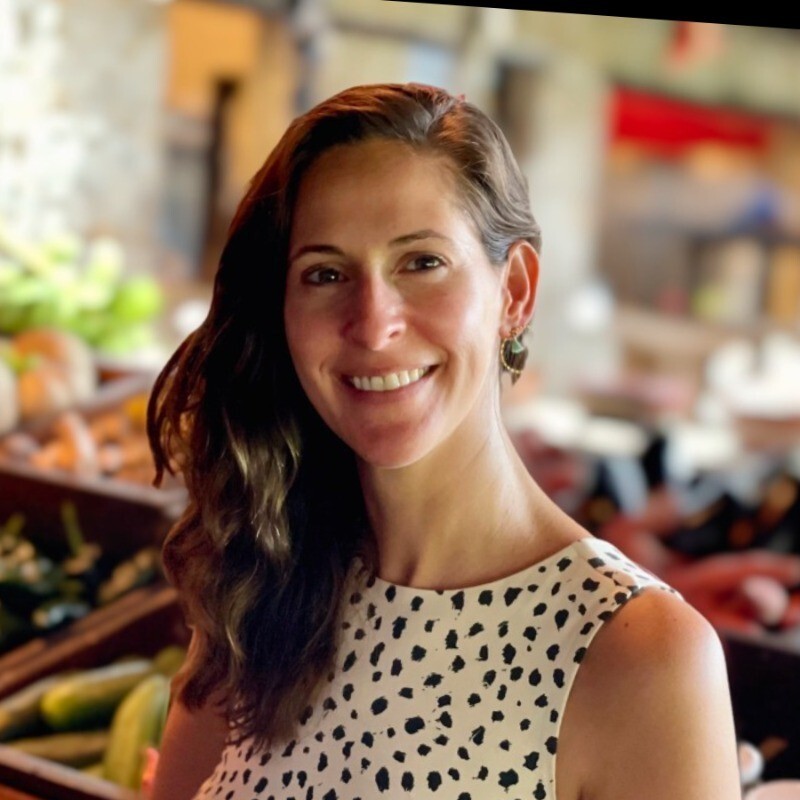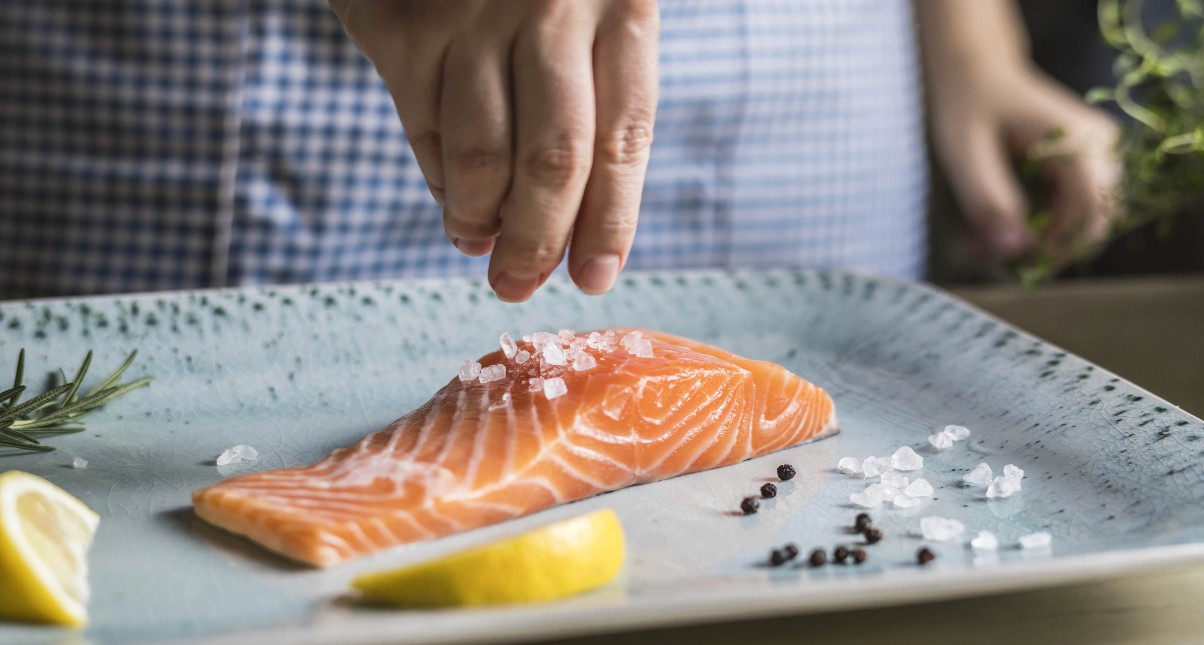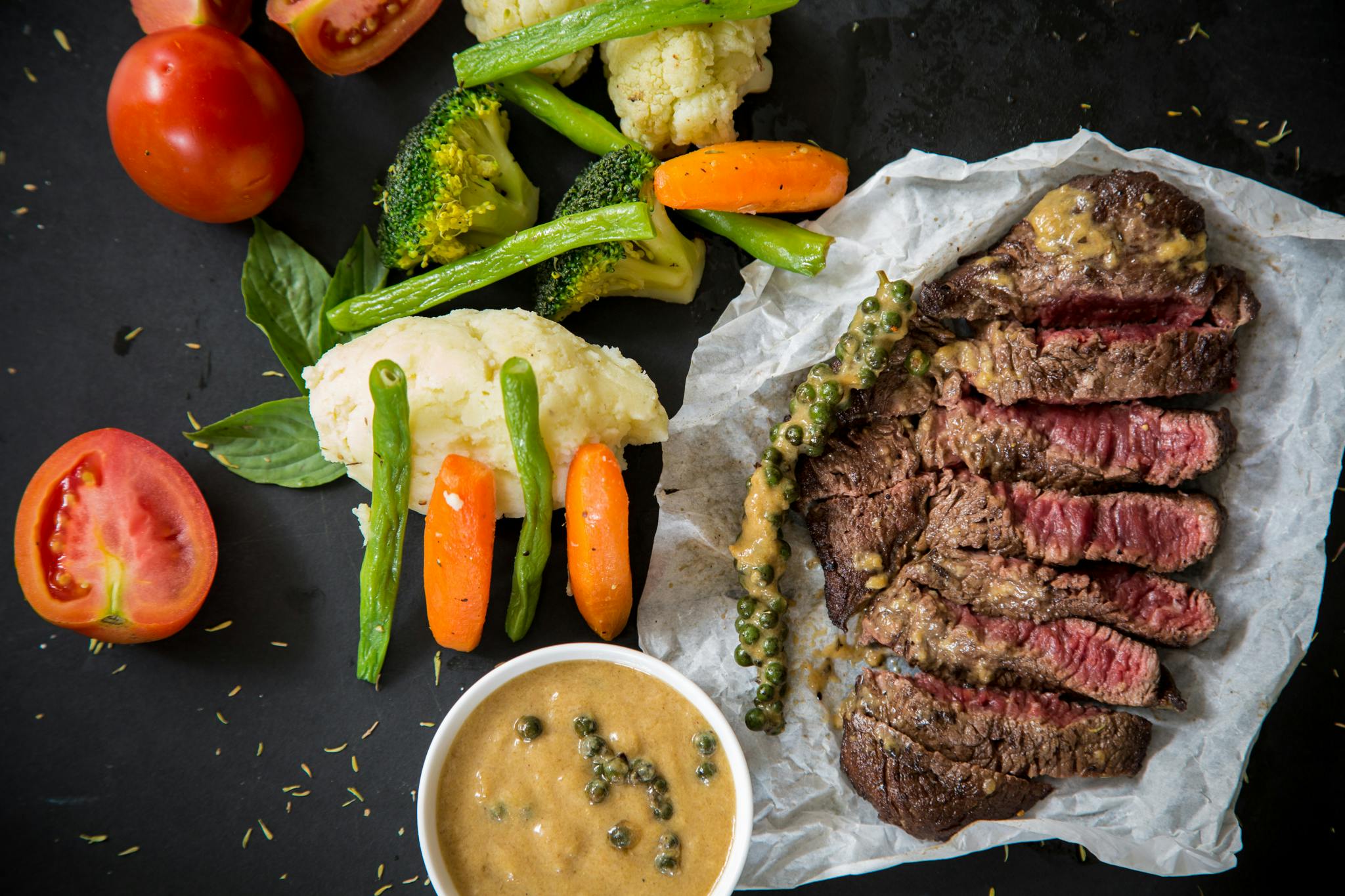As a versatile fish that’s full of flavor, salmon deserves a place in every kitchen’s meal rotation. Not to mention, it’s packed with tons of nutrients that are beneficial for your health. Salmon is a lean protein source that’s rich in omega-3 fatty acids, a heart healthy fat that can help fight inflammation and support brain function.
Safe to say, as far as foods go, salmon is quite the catch. The best part is that there are endless ways you can enjoy it, no matter the occasion or time of the year. Take inspiration from some of our favorite ways below.
Baked
One of the easiest ways to cook salmon is in the oven, on a baking sheet. Simply lay the filets out on a sheet, rub them with some olive oil, salt, and pepper, and roast them skin-down at 425°F. They’ll cook quickly too - take a look after 8 minutes, and if the flesh is opaque and flakes easily, it’s done!
Pan-Seared
Pan-searing salmon has the advantage of yielding crispy, crunchy skin (added texture is always a bonus). For best results, pat salmon dry, season to taste, and heat olive oil in a pan over medium heat. When oil is shimmering, add salmon skin-side up and sear until golden on bottom for 3 minutes. Flip salmon and cover pan. Continue searing until fish is cooked through and opaque, 3-5 minutes more.
Poached
In comparison to other cooking methods, poaching salmon is a lighter way of preparing the protein that not only ensures you maintain the juices of the fish, but also is free of any added oils. First, bring a pan of liquid (this can be a combination of aromatics plus water, broth, or wine) to a simmer. Lower the seasoned fish inside, cover the pan, and cook for at least 10 minutes.
Grilled
Salmon can also be grilled like any other protein. Marinate it a few hours before cooking in your favorite marinade - for grilling, we recommend placing the salmon on a lightly oiled piece of foil to ensure the skin or flesh doesn’t stick to the grill. Once your grill has preheated, grill the salmon skin-side up for about 6-8 minutes. Do the same for the other side. For the best char, ensure the grill is at a medium-high heat, usually at 375 to 400°F.
En Papillote
Meaning “wrapped in paper” in French, this method of cooking salmon is deceptively simple, and is a fool-proof way of ensuring that it doesn’t overcook. By wrapping the salmon in paper and baking it, the steam gently cooks the fish, infusing it with flavor in the process. Place the salmon onto a large piece of parchment paper, layer it with seasoning, herbs, or citrus fruit like lemon, and fold it up. Bake the packets at 400°F for about 10-15 minutes. As the salmon cooks, the packets will puff up, so take care when unwrapping them.
As a versatile fish that’s full of flavor, salmon deserves a place in every kitchen’s meal rotation. Not to mention, it’s packed with tons of nutrients that are beneficial for your health. Salmon is a lean protein source that’s rich in omega-3 fatty acids, a heart healthy fat that can help fight inflammation and support brain function.
Safe to say, as far as foods go, salmon is quite the catch. The best part is that there are endless ways you can enjoy it, no matter the occasion or time of the year. Take inspiration from some of our favorite ways below.
Baked
One of the easiest ways to cook salmon is in the oven, on a baking sheet. Simply lay the filets out on a sheet, rub them with some olive oil, salt, and pepper, and roast them skin-down at 425°F. They’ll cook quickly too - take a look after 8 minutes, and if the flesh is opaque and flakes easily, it’s done!
Pan-Seared
Pan-searing salmon has the advantage of yielding crispy, crunchy skin (added texture is always a bonus). For best results, pat salmon dry, season to taste, and heat olive oil in a pan over medium heat. When oil is shimmering, add salmon skin-side up and sear until golden on bottom for 3 minutes. Flip salmon and cover pan. Continue searing until fish is cooked through and opaque, 3-5 minutes more.
Poached
In comparison to other cooking methods, poaching salmon is a lighter way of preparing the protein that not only ensures you maintain the juices of the fish, but also is free of any added oils. First, bring a pan of liquid (this can be a combination of aromatics plus water, broth, or wine) to a simmer. Lower the seasoned fish inside, cover the pan, and cook for at least 10 minutes.
Grilled
Salmon can also be grilled like any other protein. Marinate it a few hours before cooking in your favorite marinade - for grilling, we recommend placing the salmon on a lightly oiled piece of foil to ensure the skin or flesh doesn’t stick to the grill. Once your grill has preheated, grill the salmon skin-side up for about 6-8 minutes. Do the same for the other side. For the best char, ensure the grill is at a medium-high heat, usually at 375 to 400°F.
En Papillote
Meaning “wrapped in paper” in French, this method of cooking salmon is deceptively simple, and is a fool-proof way of ensuring that it doesn’t overcook. By wrapping the salmon in paper and baking it, the steam gently cooks the fish, infusing it with flavor in the process. Place the salmon onto a large piece of parchment paper, layer it with seasoning, herbs, or citrus fruit like lemon, and fold it up. Bake the packets at 400°F for about 10-15 minutes. As the salmon cooks, the packets will puff up, so take care when unwrapping them.
As a versatile fish that’s full of flavor, salmon deserves a place in every kitchen’s meal rotation. Not to mention, it’s packed with tons of nutrients that are beneficial for your health. Salmon is a lean protein source that’s rich in omega-3 fatty acids, a heart healthy fat that can help fight inflammation and support brain function.
Safe to say, as far as foods go, salmon is quite the catch. The best part is that there are endless ways you can enjoy it, no matter the occasion or time of the year. Take inspiration from some of our favorite ways below.
Baked
One of the easiest ways to cook salmon is in the oven, on a baking sheet. Simply lay the filets out on a sheet, rub them with some olive oil, salt, and pepper, and roast them skin-down at 425°F. They’ll cook quickly too - take a look after 8 minutes, and if the flesh is opaque and flakes easily, it’s done!
Pan-Seared
Pan-searing salmon has the advantage of yielding crispy, crunchy skin (added texture is always a bonus). For best results, pat salmon dry, season to taste, and heat olive oil in a pan over medium heat. When oil is shimmering, add salmon skin-side up and sear until golden on bottom for 3 minutes. Flip salmon and cover pan. Continue searing until fish is cooked through and opaque, 3-5 minutes more.
Poached
In comparison to other cooking methods, poaching salmon is a lighter way of preparing the protein that not only ensures you maintain the juices of the fish, but also is free of any added oils. First, bring a pan of liquid (this can be a combination of aromatics plus water, broth, or wine) to a simmer. Lower the seasoned fish inside, cover the pan, and cook for at least 10 minutes.
Grilled
Salmon can also be grilled like any other protein. Marinate it a few hours before cooking in your favorite marinade - for grilling, we recommend placing the salmon on a lightly oiled piece of foil to ensure the skin or flesh doesn’t stick to the grill. Once your grill has preheated, grill the salmon skin-side up for about 6-8 minutes. Do the same for the other side. For the best char, ensure the grill is at a medium-high heat, usually at 375 to 400°F.
En Papillote
Meaning “wrapped in paper” in French, this method of cooking salmon is deceptively simple, and is a fool-proof way of ensuring that it doesn’t overcook. By wrapping the salmon in paper and baking it, the steam gently cooks the fish, infusing it with flavor in the process. Place the salmon onto a large piece of parchment paper, layer it with seasoning, herbs, or citrus fruit like lemon, and fold it up. Bake the packets at 400°F for about 10-15 minutes. As the salmon cooks, the packets will puff up, so take care when unwrapping them.
As a versatile fish that’s full of flavor, salmon deserves a place in every kitchen’s meal rotation. Not to mention, it’s packed with tons of nutrients that are beneficial for your health. Salmon is a lean protein source that’s rich in omega-3 fatty acids, a heart healthy fat that can help fight inflammation and support brain function.
Safe to say, as far as foods go, salmon is quite the catch. The best part is that there are endless ways you can enjoy it, no matter the occasion or time of the year. Take inspiration from some of our favorite ways below.
Baked
One of the easiest ways to cook salmon is in the oven, on a baking sheet. Simply lay the filets out on a sheet, rub them with some olive oil, salt, and pepper, and roast them skin-down at 425°F. They’ll cook quickly too - take a look after 8 minutes, and if the flesh is opaque and flakes easily, it’s done!
Pan-Seared
Pan-searing salmon has the advantage of yielding crispy, crunchy skin (added texture is always a bonus). For best results, pat salmon dry, season to taste, and heat olive oil in a pan over medium heat. When oil is shimmering, add salmon skin-side up and sear until golden on bottom for 3 minutes. Flip salmon and cover pan. Continue searing until fish is cooked through and opaque, 3-5 minutes more.
Poached
In comparison to other cooking methods, poaching salmon is a lighter way of preparing the protein that not only ensures you maintain the juices of the fish, but also is free of any added oils. First, bring a pan of liquid (this can be a combination of aromatics plus water, broth, or wine) to a simmer. Lower the seasoned fish inside, cover the pan, and cook for at least 10 minutes.
Grilled
Salmon can also be grilled like any other protein. Marinate it a few hours before cooking in your favorite marinade - for grilling, we recommend placing the salmon on a lightly oiled piece of foil to ensure the skin or flesh doesn’t stick to the grill. Once your grill has preheated, grill the salmon skin-side up for about 6-8 minutes. Do the same for the other side. For the best char, ensure the grill is at a medium-high heat, usually at 375 to 400°F.
En Papillote
Meaning “wrapped in paper” in French, this method of cooking salmon is deceptively simple, and is a fool-proof way of ensuring that it doesn’t overcook. By wrapping the salmon in paper and baking it, the steam gently cooks the fish, infusing it with flavor in the process. Place the salmon onto a large piece of parchment paper, layer it with seasoning, herbs, or citrus fruit like lemon, and fold it up. Bake the packets at 400°F for about 10-15 minutes. As the salmon cooks, the packets will puff up, so take care when unwrapping them.
As a versatile fish that’s full of flavor, salmon deserves a place in every kitchen’s meal rotation. Not to mention, it’s packed with tons of nutrients that are beneficial for your health. Salmon is a lean protein source that’s rich in omega-3 fatty acids, a heart healthy fat that can help fight inflammation and support brain function.
Safe to say, as far as foods go, salmon is quite the catch. The best part is that there are endless ways you can enjoy it, no matter the occasion or time of the year. Take inspiration from some of our favorite ways below.
Baked
One of the easiest ways to cook salmon is in the oven, on a baking sheet. Simply lay the filets out on a sheet, rub them with some olive oil, salt, and pepper, and roast them skin-down at 425°F. They’ll cook quickly too - take a look after 8 minutes, and if the flesh is opaque and flakes easily, it’s done!
Pan-Seared
Pan-searing salmon has the advantage of yielding crispy, crunchy skin (added texture is always a bonus). For best results, pat salmon dry, season to taste, and heat olive oil in a pan over medium heat. When oil is shimmering, add salmon skin-side up and sear until golden on bottom for 3 minutes. Flip salmon and cover pan. Continue searing until fish is cooked through and opaque, 3-5 minutes more.
Poached
In comparison to other cooking methods, poaching salmon is a lighter way of preparing the protein that not only ensures you maintain the juices of the fish, but also is free of any added oils. First, bring a pan of liquid (this can be a combination of aromatics plus water, broth, or wine) to a simmer. Lower the seasoned fish inside, cover the pan, and cook for at least 10 minutes.
Grilled
Salmon can also be grilled like any other protein. Marinate it a few hours before cooking in your favorite marinade - for grilling, we recommend placing the salmon on a lightly oiled piece of foil to ensure the skin or flesh doesn’t stick to the grill. Once your grill has preheated, grill the salmon skin-side up for about 6-8 minutes. Do the same for the other side. For the best char, ensure the grill is at a medium-high heat, usually at 375 to 400°F.
En Papillote
Meaning “wrapped in paper” in French, this method of cooking salmon is deceptively simple, and is a fool-proof way of ensuring that it doesn’t overcook. By wrapping the salmon in paper and baking it, the steam gently cooks the fish, infusing it with flavor in the process. Place the salmon onto a large piece of parchment paper, layer it with seasoning, herbs, or citrus fruit like lemon, and fold it up. Bake the packets at 400°F for about 10-15 minutes. As the salmon cooks, the packets will puff up, so take care when unwrapping them.





